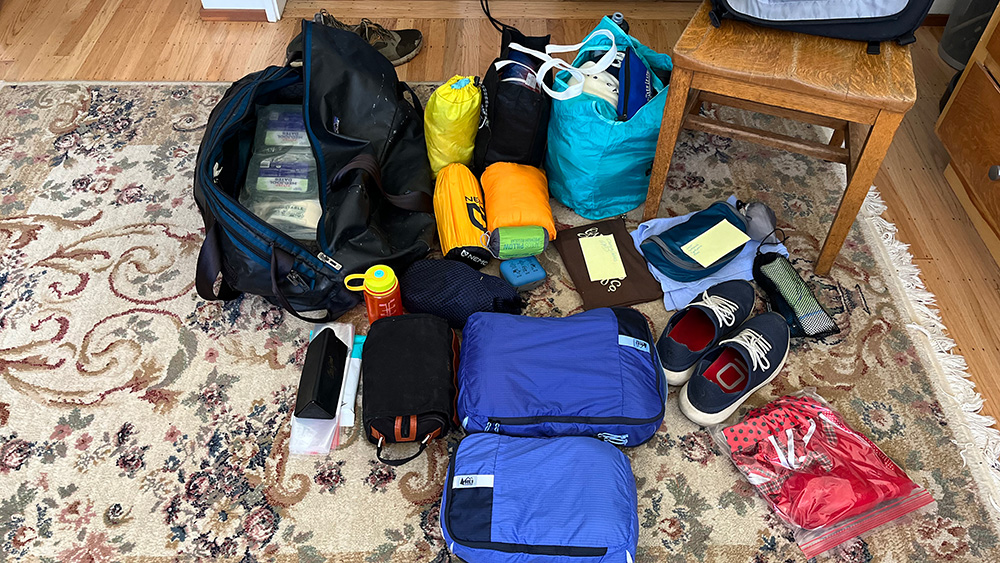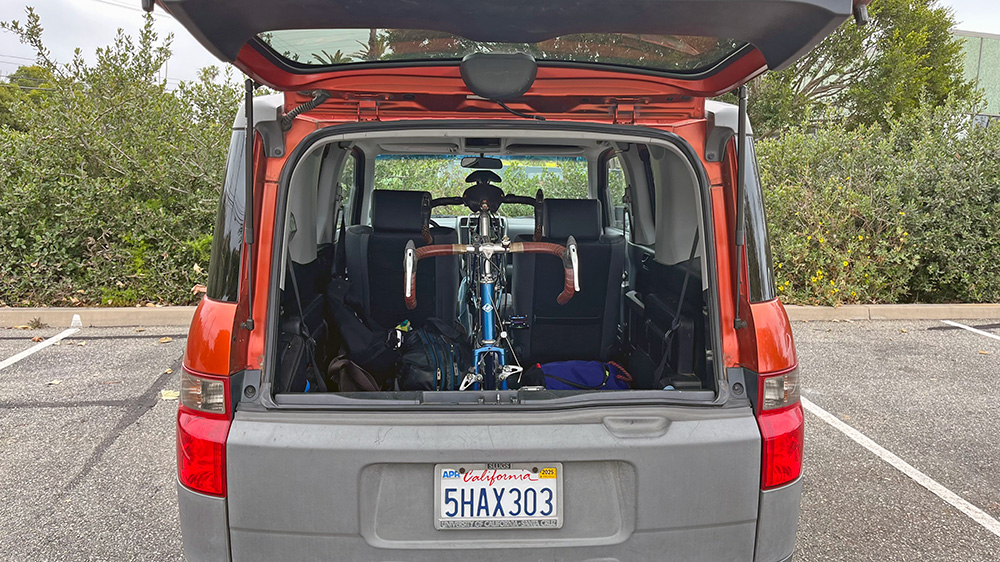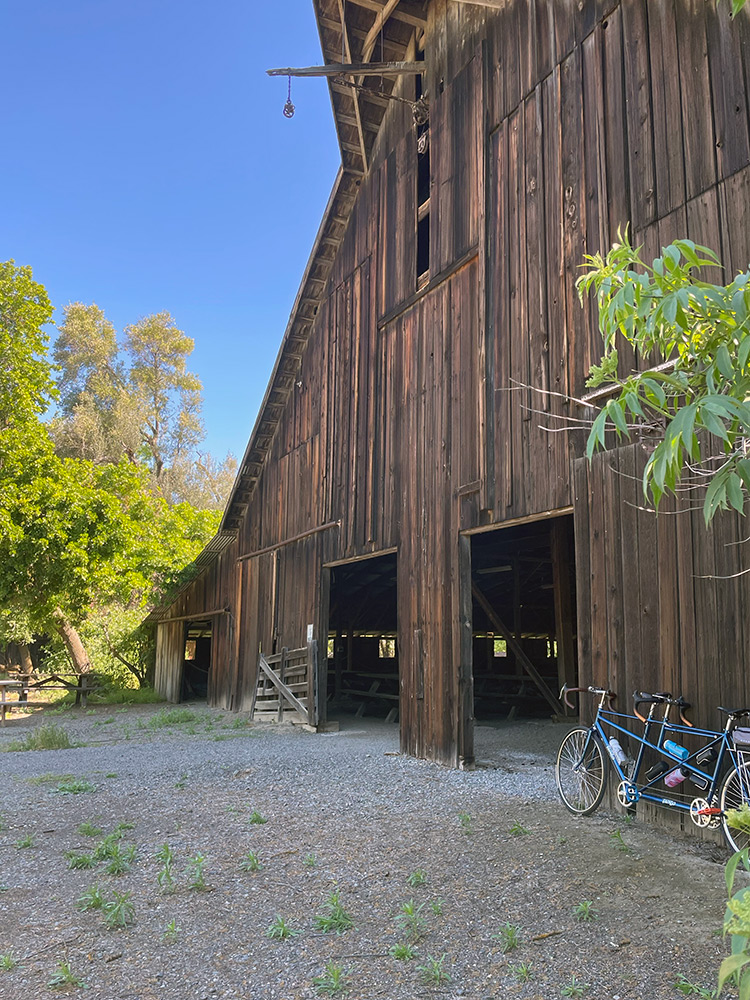From Scott…

Riding a tandem successfully takes practice. It’s not, as the phrase goes, just like riding a bike. Oh, would that it ’twere so simple.
Kathy has a phrase she coined, something about having all the parts of a puzzle and putting the pieces together differently . . . I don’t know exactly how it goes. But basically it’s about how successful tandem riding means re-learning to ride a bike and re-thinking about how you ride that bike. That is, approaching a familiar experience in a completely new way.
Because if two people, each capable of independent thought, want to ride together on one bike, it’s important to make sure you’re thinking more or less along the same lines. That’s an entirely different experience from riding a single bike.
The most likely circumstances to fall over on a tandem are at starts and stops. For instance, if one puts their left foot down at a stop and the other puts their right foot down, there is high likelihood that the bike will tilt contrary to one rider’s expectations. That person will be caught off guard, and everybody will end up on the ground. So the first step in riding a tandem is working out how to start and stop together without crashing. And like teaching your kid how to drive, the best place to do that is a large, quiet parking lot where there is plenty of room for mistakes. Our venue of choice was one of the many lots at the Pasadena Rose Bowl.
(For those who may not know, Kathy lives in Los Angeles and I live in Davis. We’re about 400 miles apart, which adds another wrinkle to to our training. But more about that some other time.)

For our first session, we had a simple goal: to start and stop the tandem without hurting ourselves. So for the first thirty minutes or so, that’s all we did. It went something like this:
Kathy: “Pedals ready.”
Scott: “Clear back?”
Kathy: “Clear.”
Scott: “Rolling.”
—One half pedal stroke and ten feet later . . .
Scott: “Coasting . . . braking . . . stopping.”
Repeat.
Now, in more detail, it went like this:
I have to get on first so when I swing my leg over the saddle I don’t accidentally kick Kathy. I plant both feet firmly on the ground and sit down on the top tube, wedged as far back as I can against the saddle. I have both front and back brakes on and have the front wheel turned to the right, which leans the bike to the left (the side from which we both get on and off the bike). At this point the bike is as stable as possible. Kathy swings her leg over to get on and stands with both feet on the ground as well. Now we’re set.
The next step is to move the pedals in position. We have agreed always to start and stop with our left feet down. Now, we are riding on flat pedals studded with little metal spikes designed to dig into the soles of our shoes for traction. I can’t see behind me very well, so Kathy is responsible for moving the right pedal into position. Otherwise, I might rotate it into her shin, which would draw blood. Not a good look on a tandem, nor a good start to building trust. Now, if she fails to tell me she’s moving the pedals, I could be the victim. And to be honest, that has happened once or twice. The jury’s still out on whether that was intentional, but even if it were, I probably deserved it.
Pedals ready, Kathy says, “Pedals ready.”
Now it’s my turn. I put my right foot on the pedal and ask her to check traffic behind us because I can’t see as well and it’s safer if I keep focused forward. She tells me it’s clear. Then I straighten the front wheel, release the brakes, and say, “Rolling.” At that point we both push down on the right pedal, but only half a stroke, until our right pedal is at the bottom.
This is half of what we did for thirty minutes: Get on the bike and push it one-half pedal stroke. The other half of what we did was learn how to stop successfully. What does that entail?
We coast when we get ready to stop to drop some speed. So I say, “Coasting.” Then we need to slow down, so I say, “Braking,” and apply the brakes. Once we’re nearly stopped, I pull the brakes in tighter and say, “Stopping.” The primary reason for all of this seemingly unnecessary communication is that Kathy can’t see where we’re going very well and has no control over the normal operation of the brakes. So any sudden movement, any change in our pedal cadence or bike speed or course is going to surprise her and make her apprehensive because, basically, she has no control. I verbalize my steps in slowing and stopping the bike so she knows what to expect.
By the time we’re about to stop, I’m out of the saddle and ready to put my left foot down. I assume Kathy is too, but I have no idea because I can’t see what she’s doing. Some stokers never take their feet off the pedals. Some captains instruct them not to do so. That seems weird to me, and it does to Kathy as well.
So that’s what we practiced for thirty minutes,: “Pedals ready . . . Clear back? . . . Rolling . . .”—one half pedal stroke and ten feet later—”Coasting . . . braking . . . stopping.” Neither of us sat on the bike during this initial period.

We progressed. We practiced Kathy sitting down and getting her left foot on the pedal, at which point she tells me, “On.” Then, and only then, do I sit and bring my left foot onto the pedal. I leave it off the pedal in case something goes horribly wrong in back. That way, I can get my feet down on the pavement more quickly.
We got pretty good at that (“Pedals ready, Clear back, Rolling, On”), so we started pedaling, practicing very large circles. I should mention that this entire time, Kathy is nearly breathless. I can feel her tension through the bike. So we do everything slowly. I check after every maneuver to make sure she’s okay. And she must have been, because after another half hour of practicing turning, she says, “Let’s take a lap around the Rose Bowl!”
I agreed, but I wasn’t happy about it. Any given day half of Pasadena and the surrounding communities is walking, jogging, running, baby-strollering, cycling, and driving around the Rose Bowl. And they all have ear buds in. Not the safest venue for two people who have to verbalize every maneuver. But we did it. And not only survived, but gave us both confidence that yes, we might be able to ride this bike together and yes, it might even be fun.



Pingback: Getting Started – Two for the Road
Brings back great memories of when we started riding our tandem. We were told at the time from other tandemistas that we’d either strengthen our marriage or get a divorce (still happily married). Looking forward to your ride blog in June,